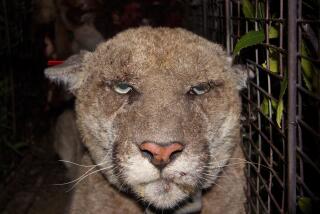Park Agencies Squabble Over Wild Turkeys
In the latest debate over which animals should live in the wilds of California, the National Park Service is furious over a plan to increase the state’s population of nonnative wild turkeys.
The state Department of Fish and Game is proposing to release turkeys at six sites in the mountains of Northern California to give hunters a better chance of bagging one of the giant birds on public lands.
But federal officials are worried that the birds will eventually wander into six popular national parks--Yosemite, Sequoia and Kings Canyon, Point Reyes, Lassen Volcanic and Redwoods--where they may gobble up native plants and animals.
In a recent letter to state Fish and Game officials, Yosemite Supt. David Mihalic wrote: “We are all the more surprised at this proposal considering the massive and growing body of scientific evidence that shows nonnative species represent one of the greatest threats to native ecosystems.”
Species Is Not a California Native
Officials at the other national parks have registered similar complaints, or plan to do so. California state parks officials also oppose the proposal, claiming the turkeys would threaten “natural biological diversity” at nine parks.
Wild turkeys are the largest game bird in North America and are common in many parts of the United States. But they aren’t native to California. Most of the state’s turkeys are here because of a massive stocking program initiated by state Fish and Game in 1959.
As a result, there are now about 100,000 of the turkeys in California, where they have been classified as a “resident game bird.” Many are on private land at low elevations, which stymies hunters stalking the birds.
The new proposal aims to increase populations at higher elevations on U.S. Forest Service land where hunting is permitted. To do this, the Department of Fish and Game plans to release up to 300 Merriam’s turkeys, a mountain species native to much of the Southwest but not California.
The 400,000-member National Wild Turkey Federation, a nonprofit conservation and hunting group based in Edgefield, S.C., is the proposal’s main backer.
“This is a case of some zealots in the federal government trying to dictate to the state of California what they should and shouldn’t do outside the parks,” said Charlie Ryan, a federation regional director. “This is not turning feral pigs loose in the Garden of Eden.”
The group also pays for half the salary of a biologist to run the state’s turkey hunting program--an arrangement not atypical in the West, but one Fish and Game officials said they will soon end because it gives the appearance of a conflict of interest.
Only Lassen Volcanic National Park is near one of the planned release sites, but park officials point out that earlier state turkey releases have resulted in birds taking up residence in Yosemite, Point Reyes and Sequoia.
The big birds, known for their sharp instincts and myriad calls, have also invaded state parks. At Cuyamaca Rancho, in the mountains of eastern San Diego County, flocks of 15 to 20 birds are a common sight. State park officials want them removed, but a trapping program has had limited success.
“The problem with this particular species of turkey is it’s something you really can’t fix, once the genie is out of the bottle,” said Yosemite chief Mihalic. “Part of the reason the American people have set aside places such as Yosemite is because of their wild values, and those values get compromised when you start putting other species in there.”
The Park Service’s mission is to protect natural wildlife “unimpaired” for future generations, making the introduction of nonnative species against agency policy.
The Department of Fish and Game concedes that no studies have been done in California on the impact of Merriam’s turkeys on other species. Agency biologists believe turkeys, which eat mostly plants, are largely a benign presence, as no serious environmental problems have been linked to them.
The National Park Service response: Get real. Park biologists said one of the first lessons of ecology is that nothing’s free--meaning, for example, an acorn eaten by a turkey is an acorn denied to native creatures.
‘The Birds Are Like a Big Vacuum’
“Even the turkey experts will tell you the birds are like a big vacuum, they’ll Hoover up everything,” said Natalie Gates, a wildlife biologist at Point Reyes.
Fish and Game wildlife biologist Scott Gardner, who wrote the turkey release plan, said the disagreements stem from the dueling missions of government agencies.
“I think [the Park Service’s] concerns are justified and we’re doing everything we can to accommodate those concerns,” he said. “It’s difficult. We have to respect their policies, but we also have our own policies, one of which is to provide hunting opportunities.”
It’s a mission, some say, that has led to interesting contradictions.
As Fish and Game seeks public comment on its turkey plan through the end of May, it’s also involved in a years-long effort to eradicate nonnative northern pike, illegally established in Lake Davis in Northern California.
Agency biologists fear that pike, a coveted game fish in the Great Lakes region and Canada, will escape from the lake and wipe out native salmon downstream.
More to Read
Sign up for Essential California
The most important California stories and recommendations in your inbox every morning.
You may occasionally receive promotional content from the Los Angeles Times.










